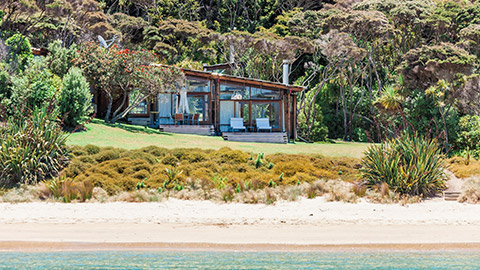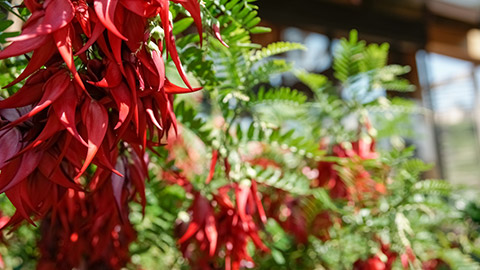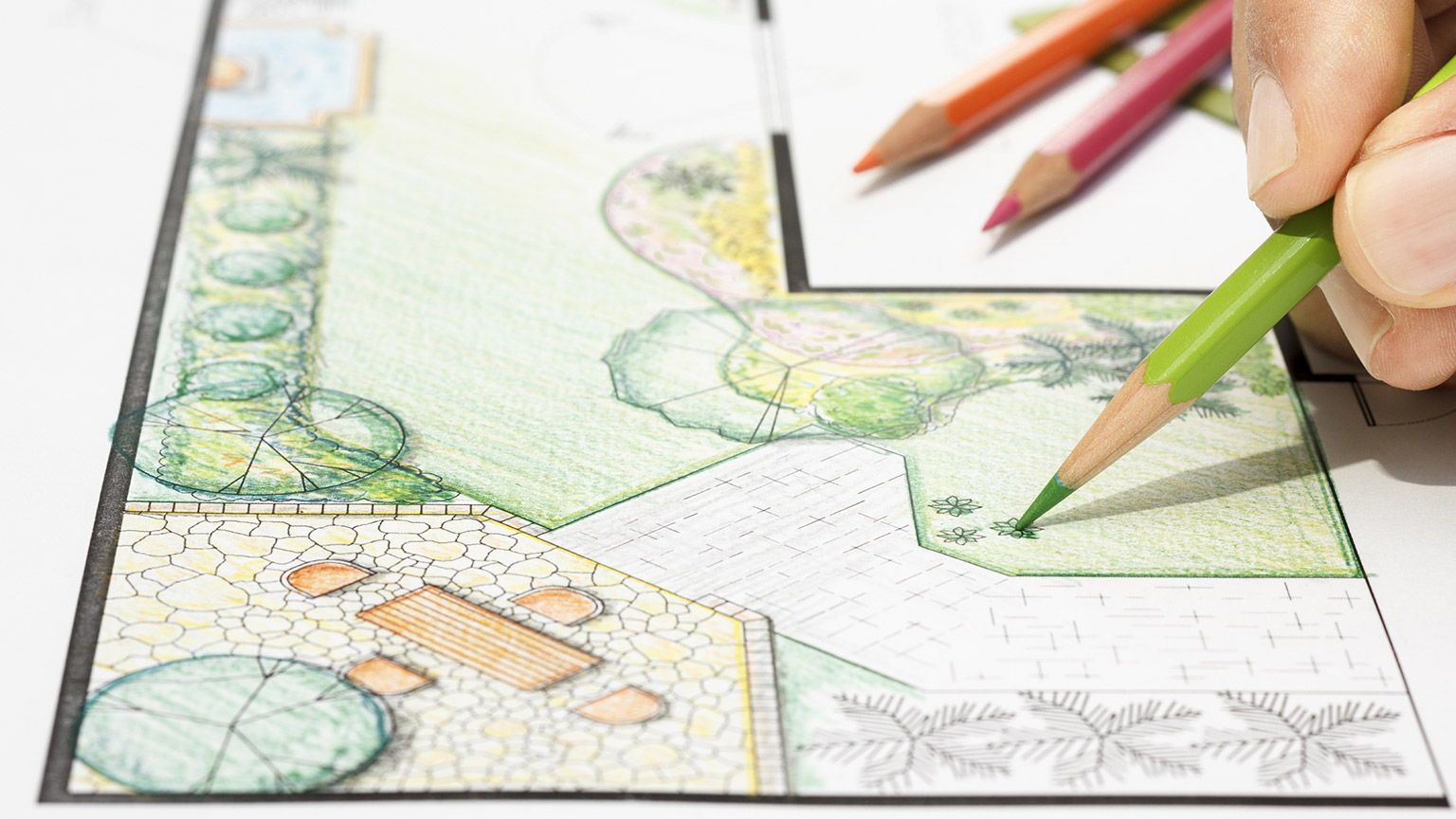This is the third module in the programme. It’s called Garden Design 1.
By the end of this module, you will be able to apply landscape design processes and knowledge of landscape design principles, garden styles, and design considerations to produce a garden design concept plan.
The module has been created to:
- introduce you to core landscape design principles, elements of design, and common garden styles
- introduce you to the first stage of the landscape design process – concept design
- give you the knowledge and skills to produce a garden design concept plan to present to your client.
Time to complete this module
This module is worth 12 Credits, which is roughly equivalent to 120 hours of learning. It will take a little less time for some people, and for others, it may take a little longer. Learning time includes reading, watching videos, completing learning activities, processing ideas, discussing what you’re learning with others, and completing the assessments.
You should aim to complete this module in:
- Full-time learners: 3 weeks
- Part-time learners: 6 weeks.
Assessment outline
To finish this module you need to complete two assessment tasks:
LDB03A1: Develop garden design concepts: To do this you will need to:
- Follow the general landscape concept design process to create at least two concepts for your chosen site.
- Use the site layout plan as a base, and the information in the client brief to inform the designs.
LDB03A2: Produce a concept plan: To do this you will need to:
- Take the concepts – typically one or two – you believe best represent the client’s requirements and draw these up as concept plans ready to present to your client. A minimum of one concept plan is required.
Go to the assessment section now and read the full assessment requirements.
We’re here to help!
Firstly, remember, it’s ok to make mistakes. When we make mistakes we can learn from them by thinking “what went wrong?” and “what can I do differently next time?”
Secondly, we’re here to help! If something doesn’t make sense, or you’re not sure what to do next, get in touch with your Tutor.
Topic content
In this topic we’ll:
- Explore a range of common garden themes through history and track the development of gardens in Aotearoa.
- Introduce useful resources related to garden themes.
- Describe a number of cultural and environmental considerations that you should give some thought to when working on your garden designs.
By the end of this topic you’ll be able to:
- Identify three historical garden styles and describe garden elements typical of these styles.
- Use online resources to find information about common garden themes.
- Match terms related to cultural and environmental conditions with their definitions.
In this subtopic we’re going to explore a range of garden styles. When we talk about garden styles we’re referring to the trends and common elements of gardens that developed in a particular place and time. For example:
- Italian renaissance gardens, for instance the Villa d'Este (from 2:44-6:37 minutes) in Tivoli, Italy
- the modernist gardens of the mid-20th century United States, such as the Donnell Garden
- contemporary naturalistic gardens, like Oudolf Field (2:51 minutes) in Summerset, UK.
This is not a garden history programme. However, having a basic understanding of garden styles will help you interpret what your clients want if they ask for you to draw inspiration from a particular style.
Historical garden styles
Gardens stretch back over 4,000 years. The following table, adapted from the Hamilton Gardens Guide Book, gives an overview of some of the gardens that have developed around the world over time. There are many more that haven’t been included.
| Garden Type | Years |
|---|---|
| Ancient Egyptian garden | ~2000BC - ~1700AD |
| Char Bagh garden tradition | ~2000BC - ~500AD |
| Chinese scholars' garden | ~0AD - ~1650AD |
| Pacific horticulture | 750AD - present |
| Muromachi era gardens | ~1000AD - 1550AD |
| Italian renaissance gardens | 1500AD - 1600AD |
| English renaissance gardens | ~1550AD - ~1625AD |
| Pre-European Maori Horticulture | ~1550AD - ~1800AD |
| European estate kitchen gardens | ~1600AD - ~1900AD |
| Chinoiserie | ~1700AD - ~1800AD |
| Picturesque garden tradition (romantic period) | ~1700AD - ~1825AD |
| Gardenesque | ~1800AD - ~1950AD |
| Early 20th century NZ gardens | ~1875AD - ~1940AD |
| Arts and crafts movement | ~1875AD - ~1920AD |
| Surrealist art movement | ~1920AD - ~1940 |
| Modernist design | ~1920AD - present |
| Conservation movement | ~1930AD - Present |
| Natural aesthetic design | ~1950AD - present |
| Conceptual gardens | ~1990AD - present |
In Aotearoa we are lucky enough to have the Hamilton Gardens, located next to the Waikato River in Hamilton, which features specific gardens designed in the styles in the timeline above. It’s worth a visit if you happen to be in Hamilton.
Watch: Hamilton Gardens - World's Best Gardens by Ian Wilson Landscape Designer (10:38 minutes)
Watch the following video by Landscape Designer Ian Wilson where he gives a tour of the Hamilton Gardens.
Pre-Watch Question: As you watch the video, take note of the names of the gardens you’d like to learn more about.
Post-Watch Task: Gardens through the ages
Choose at least three* of the gardens that you wrote the name of while you watched the video. Choose two that you think your friends or family members might like for their own garden and one that really takes your own fancy.
Go to the Hamilton Gardens website and click on the gardens that you have chosen.
For each garden, scroll through the images at the top and read the description. If you want to learn more, use the name and keywords from the text to search the internet for more information about this style of garden. Think about which elements in the garden you consider are essential to convey the garden style. Write these down as bullet points or draw a picture to capture these ideas.
* We encourage you to research more than three garden styles, but at a minimum do three. The more different garden styles you learn about the better.
As you can see there are a wide range of garden styles that have developed over the past 4,000 years, to respond to the climate and culture of different locations. More recently these themes have been adapted to different locations, so it’s not uncommon to see a Mediterranean style garden in Aotearoa.
The Aotearoa experience
WassilieffFor early New Zealanders, both Māori and European, gardens were a necessity, providing the food they needed for survival. But vegetable gardens no longer dominate backyards, and gardening has become a hobby.
Read the story of gardens in Aotearoa in this article in Te Ara The Encyclopedia of New Zealand: Gardens. The first page gives a good overview. If you’re interested, read the whole article (seven pages in total) by clicking on the ‘Next’ button at the bottom of each page.
As you can see, there have been two distinct approaches to garden design in Aotearoa, historically:
- Those that can afford it have engaged horticulture and landscaping professionals to create gardens that reflect desirable garden styles.
- Others have taken a more eclectic approach, however, these gardens have been driven, for the most part, by the functions needed from the garden.

Designed elements of this garden in the Bay of Islands blend seamlessly with the natural landscape that surrounds it.
More recently, professionally designed gardens have moved away from following a garden style to something more closely resembling a theme.
Garden themes
Garden themes (confusingly sometimes also referred to as garden styles) are a way of categorising gardens that have similar elements. The following websites provide some useful inspiration for a range of different garden themes:
- Gardenia: Garden styles – offers a short summary of a range of garden themes as well as relevant plant information. Check out the guides, plants and plant combination ideas at the bottom of the page.
- Royal Horticultural Society: Choose your style – offers a range of different garden design and plant selection ideas.
Keep in mind that both websites are based overseas so not all plants will be available in Aotearoa.
Now that you have an appreciation for a range of different garden styles and themes, we’re going to take a minute to think about the impact our design will have on the environment and surrounding community.
Cultural considerations
As mentioned earlier, it is important that we have a good sense of the history of the area to show our professionalism in working with the whenua (land). We also want to do our best to protect the site and the plants, through a sense of guardianship, or kaitiakitanga.
The following articles by two architecture students, provide useful perspectives on Te Ao Māori (Māori worldview) and kaitiakitanga (guardianship).
Readings
1. Western worldview versus Māori worldview
Summary: Jessica Tregidga is in her first year of a bachelor’s degree in architecture, with a prior Diploma in Architectural Technology. As part of her education she’s doing ‘The Landscapes of Aotearoa’ course at Unitec, which looks into how the past is influencing the present, and how we can provide for the future landscapes of Aotearoa, exploring the evolution of tāngata (people) and whenua (landscapes) in Aotearoa New Zealand, in terms of Te Ao Māori and Te Ao Pākehā / Te Ao Hurihuri (the western worldview and changing worldview).
Pre-Read Question: What do you know about pre-European Māori gardens? Are there any historic garden sites in your neighbourhood?
Read the article (5 minutes).
Post-read Task: Make a note of 3 useful things you found out from the article which could help with your own garden design.
2. The history of Aotearoa's landscape through a Māori lens
Summary: Drisana Brown is doing an internship at TOA (Tamaki Makaurau Office Architecture) which she says has been a huge opportunity to learn more about architecture and integrating Māori in design.
She’s doing ‘The Landscapes of Aotearoa’ course at Unitec, which looks into how the past is influencing the present, and how we can provide for the future landscapes of Aotearoa, exploring the evolution of tāngata (people) and whenua (landscapes) in Aotearoa New Zealand, in terms of Te Ao Māori and Te Ao Pākehā / Te Ao Hurihuri (the western worldview and changing worldview).
Pre-Read Question:What do you already know about how Māori view the connections between people and the land?
Read the article (5 minutes).
Post-read Task:Make a note of 3 useful things you found out from the article which could help with your own garden design.
Source: Landscape Architecture Aotearoa
Environmental considerations
Water use and retention
As the effects of climate change become more severe, it is important to design for both severe rain events, and drought conditions. This article from the NZ Herald makes a case for the need to design spaces that catch water and slowly feed it back into the soil and groundwater: Explainer: Why NZ’s cities need to get ‘spongier’ - and fast
While this is aimed at landscape architects and urban planners dealing with large areas, the principle also applies to garden design. Designing the garden so that water can percolate (enter) the soil rather than run-off into a stormwater drain is one approach. This is particularly important for large areas such as driveways or patios. Specifying gravel, pavers, or porous cement for these areas can help drain and filter rainwater.
On larger sites it may be possible to design swales, which are low-lying areas that rainwater can run down into and seep back into the soil during the days that follow the storm.
At the other extreme are the long, dry summers, which we are seeing more and more frequently. Additionally as more people move into urban areas, access to clean water will become more difficult. Selecting plants that are drought tolerant is one way of reducing the amount of water needed, thereby leaving more water in the system for other uses.
Sustainable design
Sustainable design is about reducing the negative impacts of a construction project by considering the whole lifecycle. Consider:
- Are there materials already on-site that can be reused?
- Are you able to source second-hand materials locally?
- For example, pavers, bricks, timber, or even broken concrete. Broken concrete is sometimes referred to as urbanite.
- Will you specify a weed mat layer beneath garden beds and hard surfaces?
- Cardboard or wool carpet can be used as alternatives to plastic sheeting.
Protecting taonga
Wherever possible, protect taonga (treasures) such as trees or stands of native trees by incorporating them into your design.
You may also like to incorporate endangered plant species into your design where the growing conditions are suitable, and they fit with the client’s requirements and the overall design. For example there are only 153 known mature Clianthus maximus (Ngutu-Kākā or kākābeak) plants in the wild, however they are easily grown from seed or cuttings and thrive in urban gardens. Their vibrant red flowers could be used as a focal point in your garden designs.

Clianthus maximus (Ngutu-Kākā or kākā beak) thrives in full sun or partial shade. Its stunning red summertime flowers attract birds.
Ka pai!
In this topic we’ve:
- explored a range of common garden themes through history and track the development of gardens in Aotearoa
- introduced useful resources related to garden themes
- described a number of cultural and environmental considerations that you should give some thought to when working on your garden designs.
In the next topic we’ll look at how to bring these concepts together by introducing the landscape design principles and landscape design elements.
